
Extrication Tips: Using the air chisel
Randy Schmitz
Features Extrication TrainingIn the January issue we talked about air chisels in general, including their basic design, function, proper use and why they are gaining popularity again.
 |
In the January issue we talked about air chisels in general, including their basic design, function, proper use and why they are gaining popularity again.
This time we’ll take a look at practical applications and uses for the air chisel.
When I teach extrication courses, students often ask why they would want to use an air chisel when hydraulics are available. My answer: why would they not want to use them? Here are a few examples of when this alternative could be quite handy:
• When performing two extrications on two separate vehicles at the same accident, such as in a head-on collision;
• When dealing with a multiple vehicle accident;
• Equipment failures such as breaking a cutter blade, spreader tip, arm or a hydraulic pump or PTO failure.
Most departments carry just one complement of hydraulic tools on a rescue truck and normally rely on mutual aid for a second set of hydraulics. Let’s assume you would rather not stand around waiting for assistance on your call.
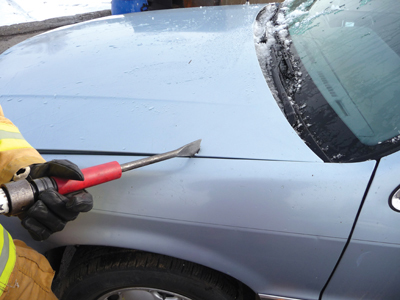 |
|
| Photo 1 Advertisement
|
|
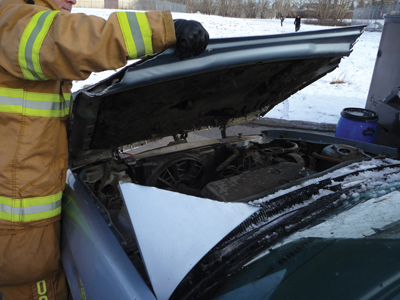 |
|
| Photo 2
|
|
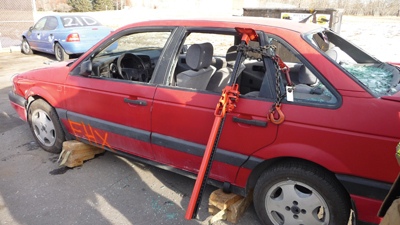 |
|
| Photo 3 |
|
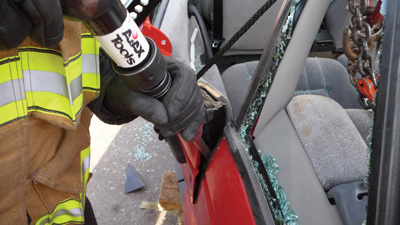 |
|
| Photo 4 |
|
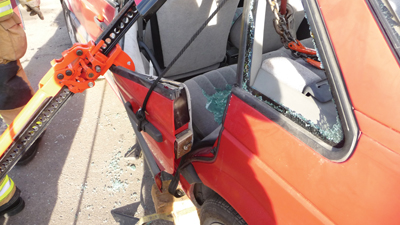 |
|
| Photo 5 |
|
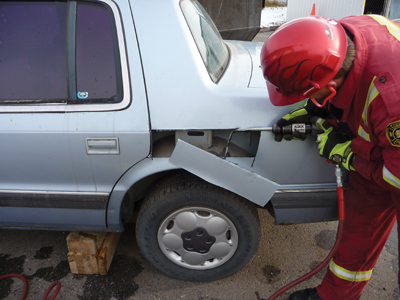 |
|
| Photo 6 |
|
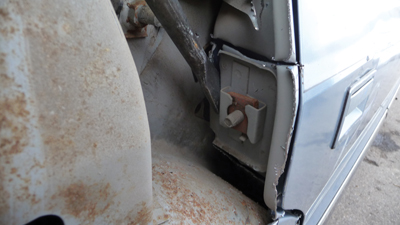 |
|
| Photo 7 |
|
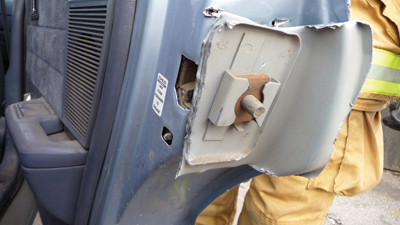 |
|
| Photo 8 |
|
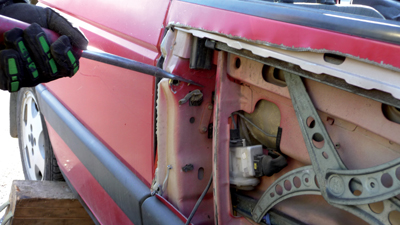 |
|
| Photo 9 |
|
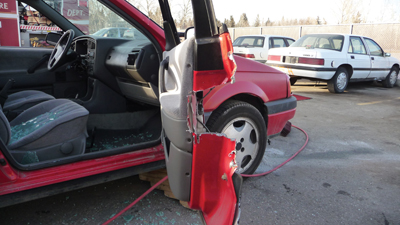 |
|
| Photo 10 |
The basics of air-chisel use
Assuming size-up, safety checks, proper PPE and vehicle stabilization have been adhered to, start with gaining access under the hood for battery disconnection. If the hood-release lever is not accessible or operational, a quick option for the air chisel is to sever the rear corners of the hood completely to allow it to open.
Choose a location about 12 inches forward of the rear corner to start the cut. This will allow the chisel bit to cut beyond the hood hinges, which are made of thicker steel, and cut only the sheet metal.
Make the cut diagonally until the hood is disconnected.
Most hoods have two layers of sheet metal with a one-inch void in between the layers, so you might have to cut the top layer first and then the second layer to completely cut through the hood.
As mentioned in January, it is imperative to keep the cutting portion of the bit about half way above the material being cut so it will not become buried or stuck.
Once you’re confident that one corner is completely severed, repeat on the opposite side. The hood can now be lifted up and bent toward the front of the vehicle with relative ease. The battery will be exposed and ready for disconnection. (See photos 1 and 2.)
Accessing passenger compartment
1. This method can be performed on both front and rear doors. Remove all tempered glass from the door frame, invert a Jackall and insert the foot plate end in the top corner of the door frame as shown in photo 3. Slide the lifting nose on to the top of the doorsill and secure the Jackall in place by wrapping a three-eights rescue chain around the C-pillar and the steel shaft of the Jackall. This will ensure that the Jackall won’t slip off the top of the window frame once it is placed under tension. Operate the Jack handle up and down a few times until there is slight tension on the door. To reduce the workload of the Jackall, chisel cut the window frame where the top of the doorsill intersects, which would be the lower right hand corner. It will take less effort to force the door open once this cut is made.
Continue to operate the Jackall until there has been enough force generated to create space between the strike plate of the door’s lock and latch mechanism and the Nader pin.
Insert an 18-inch flat chisel bit and rest the end of the bit on the Nader pin.
Similar to the way a hydraulic spreader is used, a Jackall forces the door out and down, which places stress on the lock and latch mechanism causing it to want to roll off the pin.
In a majority of cases, you can place the chisel bit on the Nader pin and vibrate the pin off the latch plate with minimal effort by simply increasing the air pressure of the air chisel to around 200 psi. (See photo 4.)
If this is not successful after a few short bursts of air, attempts can be made to sever the Nader pin to release the door. (See photo 5.)
It is a good idea to secure the door with rope from the opposite side of the vehicle to minimize the chances of it flying open.
2. This technique is a good option when manpower is at a minimum. The same concept applies as listed above except our initial access will be attempted from behind the door in the rear quarter-panel area.
Start the cut a distance equal to the length of the air chisel back from the outer edge of the door at, or slightly lower than the door handle.
The idea is to create a void in the car body that will allow the tool to be completely inserted into the quarter panel,
There needs to be enough room to articulate the end of the chisel bit to cut the back of the Nader pin’s reinforced plate where it attaches to the vehicle.
Once a large enough cut-out has been created, manipulate the bit to cut completely around the reinforcement plate that holds the Nader pin locked in position to the door latching mechanism. Once this has been completed the door and Nader pin will no longer be latched to the vehicle. (See photos 6 and 7 and photo 8)
This can also be performed on front doors – the difference is that access to the latching mechanism can be gained by cutting an access hole through the outer door skin to cut around the lock and latch mechanism (see photos 9 and 10).
Air chisel kits designed for the fire service usually come with an air impact gun. Unfortunately, this tool is often left in the box. When we talk of tools complementing each other, the chisel and the impact gun go hand in hand (see photo 11).
An excellent option for door removal in a side-impact situation is to disassemble the door in the same manner that it was constructed on the production line. Side impact intrusions will often create a space large enough between the fender and the front edge of the door to expose the door hinges.
This allows a great opportunity to take advantage of a crash-induced purchase point. Simply select the proper-sized deep socket included in the chisel kit and remove the bolts that attach the door hinges to the vehicle body. The front portion of the door will drop toward the ground and this will create a space between the Nader pin and the latching mechanism. Try to manipulate the door handle to see if it will release the Nader pin out of the door latch. If that doesn’t work, continue to use the air chisel to cut around the exposed latch to release the door.
Note: Many hours spent disassembling vehicles have shown that an imperial nine-sixteenths inch, half-inch or metric 12 millimetre or 14 millimetre bolt is the most commonly used fastener. This holds true for passenger seat rails and seat backs, door hinges and hood spring assemblies. Just remember this is not all encompassing. There will be times when these sizes will not work, such as with bolts that require star bits. One way to differentiate the common sockets is to put coloured labelling tape around them for quick and easy recognition.
Third door conversions
For patients trapped in the rear seating area of a two-door vehicle, a third-door conversion can be a quick and safe option. If a patient is pinned, the short penetrating strokes of a chisel bit allow good control when working to remove metal away from the patient. (See photo 12)
A couple of safety points to consider: Use hard protection between tools and patients; and remove plastic trim to identify unsuspecting locations of un-deployed roof curtain cylinders. For example, model years 2001 to 2007 of the Mini Cooper three-door hatchback hide the roof curtain cylinders inside the rear quarter panel.
Always use sharps protection on any cut or exposed sheet metal.
Kipper-can technique
The kipper-can technique received its name from extrication challenges during the hand-tool scenarios because they’re similar to opening a sardine can.
With the glass removed, the whole roof skin is cut out to locate the transversal front and rear structural cross members. Once these are exposed it becomes apparent where to make the most efficient cuts to remove them. The advantage here is the size of the egress hole from which the patient can be removed and the time saved by not having to make A, B and C pillar cuts. This option can be a good choice if the vehicle is on its side or on its wheels. (See photo 13.)
These are just a few options that can expand your toolbox, so encourage your crew to become familiar with all available tools.
Try not to rely too much on hydraulics as you never know when they may fail or not be readily available.
Calgary firefighter and extrication instructor Randy Schmitz has been involved in the extrication field for 16 years and has competed in all levels of extrication competition including world challenges. He is the Alberta chair for Transport Emergency Rescue Committee in Canada, chair of the T.E.R.C. Canada educational committee and a judge for T.E.R.C. Canada and U.S. Contact him at rwschmitz@shaw.ca
Print this page